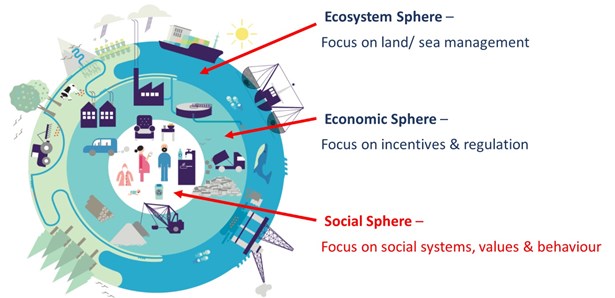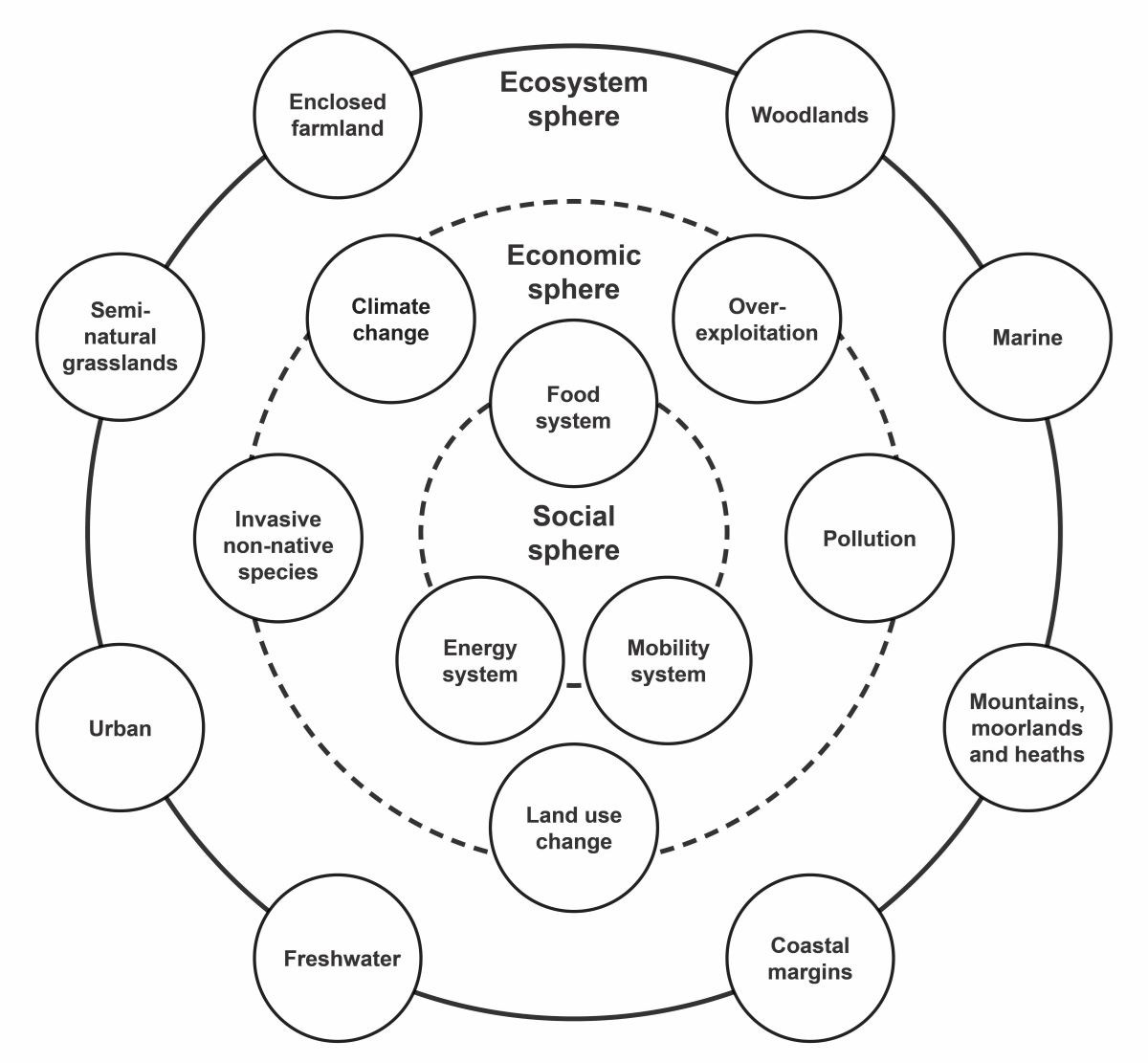SoNaRR2020: Transforming Wales
For Welsh public, private and third sectors to leverage change to tackle the nature and climate emergencies, they need to focus on the systems that support everyday life.
The Well-being of Future Generations Act provides the framework to deliver integrated change across society, economy and the environment. To look at how this can be done we have looked at delivering environmental change through the social, economic and ecosystem spheres.
While action in the ecosystem and economic spheres is focused on mitigating the impacts people are having on the planet, it is in the social sphere and in civil society that Wales can address the causes of environmental degradation at their source. That means looking at the way people live so that a range of sectors can leverage social and cultural change and rapidly establish a better fit between humans and the environment.

Figure 1: The world shown in three spheres. Social sphere at the centre surrounded by the economic sphere enclosed by the ecosystem sphere
There are many options available for pursuing a more sustainable course of development within the dynamic and ever-changing social sphere.
Huge societal transformations are happening all around us, all the time. Autonomous vehicles and renewable energy now threaten the established oil, gas, coal and car industries. Global sales of electric cars saw a 40% year-on-year increase during the last year (Global EV Outlook 2020). Wales is exploring how to use such technological and social changes, to reduce its impact on the planet.
Analysis of how lifestyles across Europe are driving environmental degradation has concluded that in order to live within environmental limits, profound changes are needed (The European environment – state and outlook 2020). There is a general need to reduce levels of production and consumption in line with United Nations sustainable development goal 12 to ‘ensure sustainable consumption and production patterns’, in pursuit of a regenerative economy. An obvious starting point is to focus on the core systems that are placing the most pressure on ecosystems. These are based around food, energy and transport (European Environmental Agency, 2019).

Figure 2: The energy, mobility and food systems shown inside the web of production and consumption systems, all shown inside the ecosystems
Ecosystems and production-consumption systems - European Environment Agency, 2019 State and Outlook ©
Looking at the food, energy and transport systems as examples of society’s systems of production and consumption allows a wider range of leverage points than have traditionally been used to regulate the environment. Examples include looking at values, behaviours and different forms of knowledge, in addition to the more traditional focus on technical and economic elements.
At the micro level for example, ‘behavioural insights’ has been used across the public and private sectors to improve understanding of people’s actions, and to achieve better outcomes though influencing human behaviour. This approach provides a scientific understanding of the drivers of human behaviour, especially non-conscious processes such as habits and emotions. It also provides insight into how the social and physical environment can be changed to influence behaviour, for example through changing the ‘default option’ to one that benefits the environment, making pro-environmental behaviours the easiest choice.
At the macro level, cross sectoral policy can be used to help redesign the energy, mobility and food systems, to pull society in line with environmental capacity. Local and national government are co-ordinating the integrated consideration of cross sectoral activities around different places and spaces. Spatial planning considers both rural and urban land use at local, regional and national scales, to look at environmental and socio-economic issues.
Designing better urban systems, bringing together both technical and creative input, will enable a better fit with the natural systems they depend on. It has been suggested that ‘Planners seeking to design resilient urban systems should start by studying the ecology of natural systems’ (Regenerative Cities, World Future Council).
Learning from how natural systems adapt to change and recycle material, would help to build a regenerative economy, one which functions within planetary limits.
The IPBES report concludes that a transition to a sustainable world is technically and economically possible, but it will require collective and individual creativity to re-imagine the way we live (Global assessment report on biodiversity and ecosystem services of the Intergovernmental Science-Policy Platform on Biodiversity and Ecosystem Services).
Setting the energy, mobility and food systems at the centre of SoNaRR’s analysis of the eight broad ecosystems and the pressures on them, demonstrates that they are key leverage points for change.

Figure 3: The energy, mobility and food systems shown inside the web of production and consumption systems, all shown inside the ecosystems
Read next
SoNaRR2020: Transforming the food system
SoNaRR2020: Transforming the energy system
SoNaRR2020: Transforming the transport system





